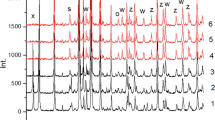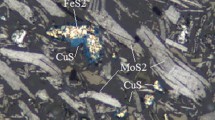Abstract
Kinetics of the direct hydrogen reduction of a high-grade (59 pct Mo) molybdenite (MoS2) concentrate was investigated in the presence of lime as a function of the quantity of lime in the charge, hydrogen flow rate, temperature, and time of reduction. Lime was found to enhance tremendously the reduction rate of MoS2 and drastically reduce H2S emission into the off gas to negligible levels. Successful application of the lime-hydrogen reduction technique was found to depend on the employment of low hydrogen flow rate and moderate temperatures of reduction. In these laboratory studies, best results were obtained with a lime addition ≥ three times the theoretical requirement and at 1173 K in 3.6 ks employing a hydrogen flow rate of 3.33 cm3s-1. The results were tested for the treatment of a low-grade (41 pct Mo) molybdenite concentrate. In this latter case, the procedure consisted of upgrading the concentrate by acid leaching (with dil HC1+HF) followed by lime-hydrogen reduction. The influence of quantity of acids, temperature, and time of leaching were investigated to optimize the conditions required for upgrading the MoS2 concentrate. The molybdenum powders obtained from the highgrade as well as upgraded molybdenite concentrates had 96 to 97 pct purity and could be further refined to 99.9 pct by electron-beam melting. Based on this lime-enhanced hydrogen reduction concept, a new ‘Leach-Reduction-Melting’ approach has been suggested as an alternative to the traditional methods of molybdenum extraction.
Similar content being viewed by others
References
A.N. Zelikman, O.E. Krein, and G.V. Samsonov:Metallurgy of Rare Metals, Israel Program for Scientific Translations, Jerusalem, 1966, pp. 60–98.
W. G. Scholz, D. V. Doane, and G. A. Timmons:Trans. TMS-AIME, 1961, vol. 221, pp. 356–64.
Y. Maru, K. Ito, and Y. Kondo:Proc. Int. Conf. Thermal Analysis, R.E. Schwenker, Jr., and P.D. Gam, eds., Academic Press, New York, NY, 1969, pp. 1291–313.
D.O. Buker: U.S. Patent no. 3,966,459, June 29, 1976.
J. S. Nachtman and H. G. Poole: U. S. Patent nos. 3,020,151, February 6, 1962, and 3,090,686, May 21, 1963.
C. Krey, H.G. Poole, andS.U. Shelton: NASA Document No. 6,318,058, 1963.
R. A. Foos and M. A. Hobin: U. S. Patent nos. 3,053,614, September 11, 1962, and 3,146,093, August 25, 1964.
O.K. Mehra, C. K. Gupta, and P. K. Jena:Trans. Indian Inst. Metals, 1968, vol. 21, no. 1, pp. 45–48.
R. Venkataramani, D. K. Bose, and P. K. Jena:Trans. Indian Inst. Metals, 1970, vol. 20, no. 1, pp. 13–16.
T.K. Mukherjee and C.K. Gupta:Metall. Trans., 1974, vol. 5, pp. 707–13.
A. K. Suri and C. K. Gupta:Trans. Indian Inst. Metals, 1973, vol. 26, no. 6, pp. 19–23.
A.K. Suri and C.K. Gupta:Metall. Trans. B, 1975, vol. 6B, pp. 453–56.
K. U. Nair, D. K. Bose, and C. K. Gupta:Min. Engg., 1978, vol. 30, pp. 291–96.
F. Habashi and R. Dugdale:Metall. Trans., 1973, vol. 4, pp. 1865–71.
F. Habashi and B. I. Yostos:J. Metals, 1977, vol. 29, no. 7, pp. 11–16.
T. R. Mankhand: Ph.D. Thesis, Banaras Hindu University, Varanasi, India, 1979.
I.D. Shah and P.L. Ruzzi:Metall. Trans. B, 1978, vol. 9B, pp. 247–53.
A. E. Torma and O. T. Inal:J. Less Common Metals, 1979, vol. 64, pp. 107–14.
P. M. Prasad and T. R. Mankhand:Trans. Indian Inst. Metals, 1979, vol. 32, pp. 253–85.
I. Barin and O. Knacke:Thermochemical Properties of Inorganic Substances, Springer-Verlag, New York, NY, 1973, pp. 174, 295, 316, and 325.
I. Barin, O. Knacke, and O. Kubaschewski:Supplement to Thermo-chemical Properties of Inorganic Substances, Springer-Verlag, New York, NY, 1977, pp. 104, 415, and 419.
H. Kay:High Temperature Refractory Metals, AIME Met. Soc. Conf., February 1965, W. A. Krivsky, ed., Gordon and Breach, New York, NY, 1968, pp. 33–44.
T. R. Mankhand and P. M. Prasad:Trans. Indian Inst. Metals, 1979, vol. 32, pp. 348–52.
R. S. Young:Chemical Analysis in Extractive Metallurgy, Charles Griffin and Co. Ltd., London, 1971, p. 318.
A.A. Gavrilova and V. S. Altschuler:Gazov. Protessy, Poluch. Energ. Technol. Gazov. Akad. Nauk. SSSR, Inst. Goryuch Iskop, 1967, pp. 91–99 (Chem. Abs., 1968, vol. 68, no. 81162h).
F. Habashi and S.A. Mikhail:Thermochimica Acta, 1977, vol. 18, pp. 319–22.
J.D. Ford and M. A. Fahim:Metall. Trans. B, 1975, vol. 6B, pp. 461–64.
T. R. Mankhand, G. Singh, and P. M. Prasad:Trans. Indian Inst. Metals, 1978, vol. 31, pp. 194–200.
Y. K. Tang: Ph.D. Thesis, The Ohio State University, Columbus, OH, 1976.
Author information
Authors and Affiliations
Rights and permissions
About this article
Cite this article
Mankhand, T.R., Prasad, P.M. Lime-enhanced hydrogen reduction of molybdenite. Metall Trans B 13, 275–282 (1982). https://doi.org/10.1007/BF02664585
Received:
Issue Date:
DOI: https://doi.org/10.1007/BF02664585




